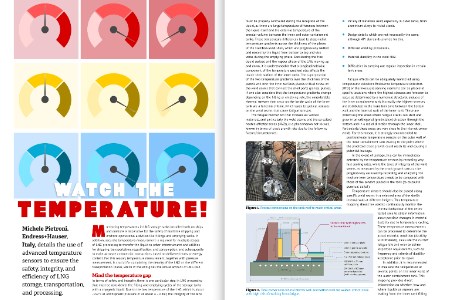[ad_1]
Monitoring temperatures in LNG storage tanks installed both on ships and onshore is imperative for the safety of maritime shipping and onshore operational activities like fillings and emptying tanks. In addition, accurate temperature measurement is required for multiple stages of LNG processing to transfer the liquid to other infrastructures and utilities for shipping, transportation, regasification, and consumption, and subsequently to make accurate commercial transactions based on delivered mass or energy content. For this reason, temperature measurement, together with pressure measurement, is crucial for calculating the density of the LNG on the different trans-portation routes, which in the end gives the actual amount of LNG sold.
Mind the temperature gap
In terms of safety and integrity, there is one particular step in LNG processing that must be considered: the filling and emptying cycles of the storage tanks with a cryogenic liquid. Due to the low temperature of the LNG, which is about -162°C at atmospheric pressure or at about 4 – 6 bar, the integrity of the tank must be properly controlled during the reception of the liquid, as there are large temperature differences between the liquid itself and the external temperature of the annular volume between the inner and outer containment tanks. These temperature differences lead to steep radial temperature gradients across the thickness of the plates of the stainless-steel shell, which are progressively wetted and cooled by the liquid from bottom to top and vice versa during the emptying phase. Considering the free liquid surface and the vapour phase of the LNG moving up and down, it is understandable that a longitudinal/axial component of the temperature gradient also affects the inside shell surface of the inner tanks. The superposition of the two temperature gradients over the thickness of the panels and over the inner surfaces places critical stress on the weld seams that connect the shell parts (panels, plates). If one also considers that the temperature gradients change depending on the filling or emptying rate, the considerable thermal stresses that occur on the inside walls of the inner tank are a function of time, which leads to cyclical stresses on the weld seams that cause fatigue stresses.
The fatigue mechanism that stresses all wetted materials, and particularly the weld seams and the so-called heated affected zones (HAZs), is a phenomenon not so well known in terms of crack growth rate due to the following factors/circumstances:
- Variety of materials used, especially in older tanks, from aluminium alloys to nickel steels.
- Design details which are not necessarily the same, although API standards provide for this.
- Different welding procedures.
- Material ductility in the weld HAZ.
- Difficulties in carrying out regular inspection in certain tank areas.
Fatigue effects can be adequately monitored using temperature detection. Resistance temperature detectors (RTD) or thermocouple sensing elements can be placed at specific locations where the highest stresses are foreseen to occur, as determined by a numerical structural analysis of the inner containment tank. Normally, the highest stresses are distributed in the transition zone between the bottom wall and the internal wall of the inner tank. These are potentially the areas where fatigue cracks can start and grow in an orthogonal (predictable) direction through the bottom and in a radial direction through the inner shell. Particularly, these areas are very close to the internal corner welds. For this reason, it is strongly recommended to position/route temperature sensors on the outer wall of the inner containment tank exactly to the point where the predicted crack growth could reach its end causing a potential leakage.
In the event of leakage, this can be immediately detected by the temperature sensors by recording very fast cooling rates, while the level of integrity of the weld seams, as measured by the crack growth rate, can be progressively assessed by recording and analysing the medium-term temperature trends to be compared with those of the sensors placed in the tank (to calculate punctual deltaT).
Temperature sensors should also be placed along specific weld seams in a selected area of the shell’s internal wall at different heights. This temperature mapping should be used to continuously monitor the thermal behaviour of the entire tested area to obtain information about possible changes in material ductility due to temperature cycling. These temperature measurements can be processed to determine the actual material condition (ductility vs brittleness), calculate the current fatigue life and even to define inspection requirements, such as frequency and criteria of ductility acceptance prior to repair.
Enjoyed what you’ve read so far? Read the full article and the rest of the June issue of LNG Industry by registering today for free!
Read the article online at: https://www.lngindustry.com/special-reports/13062024/watch-the-temperature/
[ad_2]
Source link
